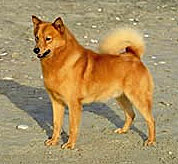|
The Canine Chronicles Directory
Finnish Spitz

The Finnish Spitz is a medium-sized, lively dog with a double coat. The abundant
undercoat has straight hair. The thick outer coat is medium in length and stands
erect. The colors of the coat include red/brown or yellow/red. Small white markings
are also permitted when showing the dog. Puppies are generally born dark and develop
their reddish coats as they mature. The wedge shaped head should be slightly longer
than broad with a pointed muzzle. The skull should have a slightly arched forehead
and a moderate stop. The almond-shaped eyes should be dark and the ears erect. Triangular
shaped ears should be small sitting high on the head. The teeth should be in a scissor-like
bite and both nose and lips should be black. The squarely proportioned body has
a deep chest reaching the elbows and a level topline. The forelegs should be straight
with strong medium bones and the hindlegs, strong with a moderate angulation. The
cat-like paws are round. The plumed tail should curve forward from the root, over
the back and down the side, level with the back and should not reach below the hock.
|
|
Temperament
|
Finnish Spitz's are a friendly, playful, and curious breed. They are independent
and somewhat aloof; however, they demand affection and attention. They are very
loyal to their families. They also make excellent companions especially for children
and older adults. They can be reserved with strangers. Males may be dog aggressive,
but adequate socialization will help prevent this behavior. They mature slowly,
not reaching adulthood until they are 3½ to 4 years old. The breed has been
nicknamed the 'Barking Hunting Dog' of Finland. These dogs love to bark and in competitions
have been known to bark up to 160 times in a minute.
|
|
Height, Weight
|
Height: 15-20" ; Weight: 31-35 lbs.
|
|
Health Problems
|
This breed has one of the lowest occurrences of hip dysplasia of any breed.
|
|
Living Conditions
|
Finnish Spitz will do okay in an apartment. They do better with an average size
yard. Remember that they are bred to bark and prefer cooler climates.
|
|
Exercise
|
This breed needs regular and vigorous exercise. They make excellent jogging companions.
|
|
Life Expectancy
|
About 12-15 years
|
|
Grooming
|
As with most Arctic Dogs, the Finnish Spitz has a self-cleaning coat and no doggy
odor. Regular brushing is necessary as this dog is a heavy seasonal shedder.
|
|
Origin
|
The Finnish Spitz or Suomenpystykorva is the national dog of Finland. This breed
was thought to have originated several thousands of years ago when the Finno-Ugrian
people lived in the Volga River Area of Central Russia. Then about 2000 years ago,
the proto-Finnic tribe moved deeper into Finland taking their dogs with them. The
dogs lived in densely wooded areas with sparse populations. Due to this, they did
not come into contact with other dogs and remained pure bred developing in accordance
with the hunter's needs. In 1875, the first official documentation of this breed
was scribed by French explorer De La Martiniere. In his writings he described "Deep
Red Dogs" that he came across while he was traveling in the Muurmanni Coast. Forest
Officer Hugo Richard Sandberg was the first to produce an informative description
of the breed. In 1889-1890, the Finnish Kennel Club was formed and they eventually
approved Sandberg's description of the breed. A special show was organized in December
of 1892 for the Finnish Spitz in Oulu. The winner of this show was 'Kekki' and was
included in the first breed book of the FKC. However, it wasn't until 1897 that
the breed standardization was confirmed. Once this occurred, the name of the breed
became The Finnish Spitz. The breed was introduced to the British Isles in the 1920s
and has since been popular in several countries throughout the world. They are recognized
by the AKC and the UKC.
|
|
Group
|
AKC Non-Sporting, UKC Northern Breed
|